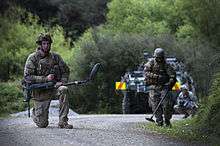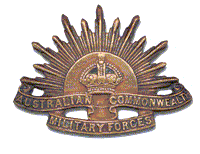1st Brigade (New Zealand)
| 1st Brigade | |
|---|---|
| Active |
1916–c. 1919 1939–1944 1946–1980s 2011–current |
| Country |
|
| Branch |
|
| Part of | Land Component Commander |
| Headquarters | Linton Military Camp |
The 1st Brigade is currently the largest unit of the New Zealand Army, and contains most of the army's deployable units. The brigade was formed on 13 December 2011 by amalgamating the 2nd Land Force Group and 3rd Land Force Group. Its establishment formed part of the 'Army 2015' package of reforms.[1]
Previous 1st Brigades in the New Zealand Army have included a brigade in the Middle East and France, 1916-19, a home defence formation active during the Second World War (part of the North Island home defence 1st Division), and a 1 Brigade / Integrated Expansion Force formed to direct three Territorial Force-formed battalions in the 1970s and 1980s.
History
First World War
The 1st Brigade came into being in Egypt in early 1916, when the New Zealand and Australian Division was re-organized in the wake of the Gallipoli Campaign, and the New Zealand Division was formed. Under the command of Brigadier General Harry Fulton, the brigade initially consisted of four infantry battalions, being the 1st Battalions of the Auckland, Canterbury, Otago and Wellington Regiments.[2] In this configuration, the brigade was transferred to the Western Front in Europe, and fought through the Battle of the Somme before the New Zealand Division was restructured. This saw the brigade reconfigured, swapping its two South Island battalions (the 1st Canterbury and 1st Otago) with the two North Island battalions (2nd Auckland and 2nd Wellington) of the 2nd Brigade. This placed all the North Island battalions in the 1st Brigade while all the South Island formations were in the 2nd Brigade.[3] Following this, the brigade fought in the Battle of Messines[4] and the Third Battle of Ypres during 1917,[5] before helping to turn back the German Spring Offensive in early 1918,[6] and then taking part in the Allied Hundred Days Offensive in the final months of the war. After the armistice, the brigade was committed briefly to post war occupation duties until the New Zealand Division disbanded in early 1919.[7][8]
Second World War
The 1st Infantry Brigade was re-established prior to the Second World War as a Territorial Force unit manned by part-time reservists.[9]
At the outbreak of war on 3 September 1939, the 1st Infantry Brigade formed part of the field force for the Northern District. At this time it commanded the 1st Hauraki Regiment (headquartered at Paeroa), 1st North Auckland Regiment (Whangarei) and 1st Waikato Regiment (Hamilton).[10]
On 1 November 1941, the 1st Brigade became part of the newly formed Northern Division in the Northern Military District.[11] The division's two brigades were the 1st and 12th Brigade Groups.[12] Later the Northern Division became the 1st Division. The 12th Brigade Group was one of the new headquarters, and both these units continued to be manned by reservists.[9] During early 1942, camps were constructed for the 1st Brigade Group in South Auckland and the 12th Brigade Group at Kaikohe. The 1st Brigade subsequently moved to a camp near Warkworth.
After the threat of invasion passed, the 1st Brigade and the other home defence formations were reduced in size during 1943. By the end of the year the seven brigade (including 1st Brigade) and three divisional headquarters comprised a total of 44 personnel, with the soldiers assigned to the Territorial Force units they once commanded having been demobilised. All of these headquarters were disbanded on 1 April 1944.[13]
In 1950, Northern Military District directed four subordinate Area Headquarters, being Area 1 (HQ Auckland), Area 2 (HQ Tauranga), Area 3 (HQ Whangarei), and Area 4 (HQ Hamilton).
Combat Brigade Group
In 1963, the Combat Brigade Group (1st Brigade) was established, based on the Northern Military District headquarters at Auckland.[14] Headquarters Northern Military District was disestablished in 1970 and the headquarters became home to Field Force Command.[15]
Current structure

In 2011 the 1st Brigade was reformed from the headquarters of the 2nd Land Force Group at Linton Camp. Its role upon formation was to command all of the New Zealand Army's operational units, other than the 1st New Zealand Special Air Service Regiment.[16]
As of December 2011, the brigade comprised:[17]
- Headquarters, 1st Brigade (Linton Military Camp)
- 1st Battalion, Royal New Zealand Infantry Regiment (Linton Military Camp)
- 2/1st Battalion, Royal New Zealand Infantry Regiment (Burnham Military Camp)
- Queen Alexandra's Mounted Rifles (Burnham Military Camp)
- 16th Field Regiment, Royal Regiment of New Zealand Artillery (Linton Military Camp)
- 2nd Engineer Regiment (Linton Military Camp)
- 1st Signals Regiment (Linton Military Camp)
- 2nd Combat Service Support Battalion (Linton Military Camp)
- 3rd Combat Service Support Battalion (Burnham Military Camp)
- 2nd Health Services Battalion (Linton Military Camp)
- 1st Military Police Company (Trentham Military Camp)
Order of Battle
Correct as at 1 August 2012:
- 1st (New Zealand) Brigade
- Headquarters, 1st Brigade (Linton Military Camp)
- 1st Battalion, Royal New Zealand Infantry Regiment (Linton Military Camp)[Note 1]
- Alpha Company
- Victor Company
- Whiskey Company
- Support Company
- Combat Service Support Company
- 2/1st Battalion, Royal New Zealand Infantry Regiment (Burnham Military Camp)
- Alpha Company
- Bravo Company
- Delta Company
- Support Company
- Depot Company
- Combat Service Support Company
- Queen Alexandra's Mounted Rifles (Linton Military Camp)[Note 2]
- Wellington East Coast Squadron
- NZ Scots Squadron
- Waikato Mounted Rifles Squadron
- Support Squadron
- 16th Field Regiment, Royal Regiment of New Zealand Artillery (Linton Military Camp)[Note 3]
- 161 Battery
- 163 Battery
- 11/4 Battery (Papakura Military Camp)
- 2nd Engineer Regiment (Linton Military Camp)
- 1st Field Squadron
- 2nd Field Squadron
- 3rd Field Squadron (Burnham Military Camp)
- 25 Engineer Support Squadron
- Emergency Response Squadron
- 1st New Zealand Signal Regiment (Linton Military Camp)
- 1st (New Zealand) Military Intelligence Company (Trentham Military Camp)
- 2nd Signal Squadron
- 3rd Signal Squadron (Electronic Warfare) (Burnham Military Camp)
- 4th Signal Squadron (Burnham Military Camp)
- 25 Cypher Section
- 2nd Combat Service Support Battalion (Linton Military Camp)
- 10th Transport Company
- 21st Supply Company
- 2nd Workshop Company
- 5th Movements Company
- Combat Service Support Company (North) (Papakura Military Camp)
- 3rd Combat Service Support Battalion (Burnham Military Camp)
- 3rd Transport Company
- 3rd Catering & Supply Company
- 3rd Workshop Company
- 2nd Health Services Battalion (New Zealand) (Linton Military Camp)
- 1st Health Support Company (Papakura Military Camp)
- 2nd Health Support Company
- 3rd Health Support Company (Burnham Military Camp)
- 4th Health Support Company (Waiouru Military Camp)
- General Support Health Company
- Logistics Support Company
- 1st (New Zealand) Military Police Company (Trentham Military Camp)
- Linton Regional Support Centre (Linton Military Camp)
See also
Notes
Footnotes
- ↑ Transitioning to light infantry, with this process to be completed by July 2012.[16]
- ↑ Being expanded to a unit-level cavalry formation equipped with NZLAVs. To move to Linton between July and December 2012.[16]
- ↑ The regiment's three batteries are transitioning to a structure where they are equipped with a mixture of mortars and guns. Each battery will be able to use up to six L119 Light Guns and twelve 81mm mortars.[18]
Citations
- ↑ "Army Plan Takes Shape". Media releases. New Zealand Army. Archived from the original on 6 January 2012. Retrieved 26 December 2011.
- ↑ Stewart 1921, pp. 15–16.
- ↑ Stack 2011, p. 9.
- ↑ Stewart 1921, pp. 179–181.
- ↑ Harper 2007, pp. 41–44.
- ↑ Wright 2005, pp. 127–129.
- ↑ Gray 2010, pp. 377–278.
- ↑ Wright 2005, pp. 159–160.
- 1 2 Cooke 2000, p. 262.
- ↑ "The New Zealand Army September 1939 - March 1941" (PDF). The Nafziger Collection of Orders of Battle. Combined Arms Research Library. Retrieved 31 October 2016.
- ↑ "Barrowclough, Harold Eric". Dictionary of New Zealand Biography. Ministry for Culture and Heritage / Te Manatū Taonga. Retrieved 14 July 2012.
- ↑ Cooke 2000, pp. 262, 274.
- ↑ Cooke & Crawford 2011, pp. 279-281.
- ↑ Fenton 1998, pp. 113–117.
- ↑ "Agency Full Description". National Archives. Archived from the original on 2013-05-04. Retrieved 2015-09-20.
- 1 2 3 "Army 2015 – Our Future in Focus" (PDF). Army News. October 2011. pp. 14–15. Retrieved 18 June 2012.
- ↑ "1 (NZ) Brigade Organisation Chart". New Zealand Army. Retrieved 26 December 2011.
- ↑ Lieutenant Colonel Matthewston (April 2012). "Refreshing the Regiment: 16th Field Regiment's Refocus" (PDF). Army News. New Zealand Army. p. 12. Retrieved 17 June 2012.
Bibliography
- Cooke, P. (2000). Defending New Zealand: Ramparts on the Sea, 1840–1950s. Wellington: Defence of New Zealand Study Group.
- Cooke, Peter; Crawford, John (2011). The Territorials: The History of the Territorial and Volunteer Forces of New Zealand. Auckland: Random House. ISBN 978-1-8697-9446-0.
- Fenton, Damien Marc (1998). A False Sense of Security. Centre for Strategic Studies New Zealand.
- Gray, John H. (2010). From the Uttermost Ends of the Earth: The New Zealand Division on the Western Front 1916–1918. Christchurch, New Zealand: Wilson Scott. ISBN 9781877427305.
- Harper, Glyn (2007). Dark Journey: Three Key New Zealand Battles of the Western Front. Auckland, New Zealand: HarperCollins Publisher. ISBN 978-1-86950-579-0.
- Stack, Wayne (2011). The New Zealand Expeditionary Force in World War I. Men-at-Arms. Oxford, United Kingdom: Osprey. ISBN 978-1-84908-539-7.
- Stewart, H. (1921). The New Zealand Division 1916–1919. Auckland, New Zealand: Whitcombe & Tombs. OCLC 2276057.
- Wright, Matthew (2005). Western Front: The New Zealand Division in the First World War 1916–18. Auckland, New Zealand: Reed Books. ISBN 0-7900-0990-0.
